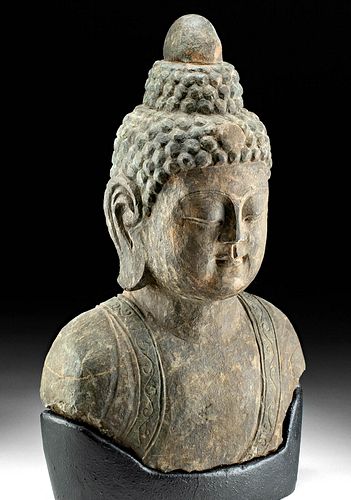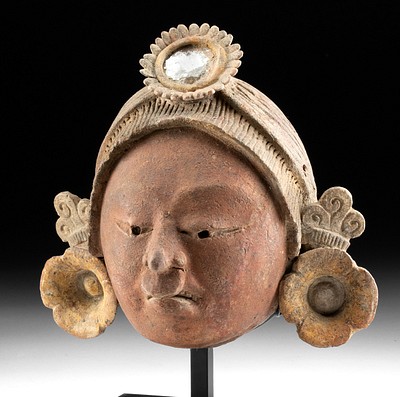Chinese Ming Dynasty Stone Bust of Buddha
Lot 72
About Seller
Artemis Fine Arts
686 S Taylor Ave, Ste 106
Louisville, CO 80027
United States
Selling antiquities, ancient and ethnographic art online since 1993, Artemis Gallery specializes in Classical Antiquities (Egyptian, Greek, Roman, Near Eastern), Asian, Pre-Columbian, African / Tribal / Oceanographic art. Our extensive inventory includes pottery, stone, metal, wood, glass and textil...Read more
Estimate:
$3,600 - $5,400
Absentee vs Live bid
Two ways to bid:
- Leave a max absentee bid and the platform will bid on your behalf up to your maximum bid during the live auction.
- Bid live during the auction and your bids will be submitted real-time to the auctioneer.
Bid Increments
| Price | Bid Increment |
|---|---|
| $0 | $25 |
| $300 | $50 |
| $1,000 | $100 |
| $2,000 | $250 |
| $5,000 | $500 |
| $10,000 | $1,000 |
| $20,000 | $2,500 |
| $50,000 | $5,000 |
| $100,000 | $10,000 |
| $200,000 | $20,000 |
About Auction
By Artemis Fine Arts
Jul 14, 2022
Set Reminder
2022-07-14 10:00:00
2022-07-14 10:00:00
America/New_York
Bidsquare
Bidsquare : Exceptional Antiquities Ethnographica Fine Art
https://www.bidsquare.com/auctions/artemis-gallery/exceptional-antiquities-ethnographica-fine-art-9692
Museum-worthy examples of classical antiquities (Egyptian, Greek, Roman, Near Eastern), Viking, Far East / Asian, Pre-Columbian, African / Tribal, Oceanic, Native American, Spanish Colonial, Fossils, Ancient Jewelry, Fine / Visual Arts, so much more! Artemis Fine Arts info@artemisfinearts.com
Museum-worthy examples of classical antiquities (Egyptian, Greek, Roman, Near Eastern), Viking, Far East / Asian, Pre-Columbian, African / Tribal, Oceanic, Native American, Spanish Colonial, Fossils, Ancient Jewelry, Fine / Visual Arts, so much more! Artemis Fine Arts info@artemisfinearts.com
- Lot Description
East Asia, China, Ming Dynasty, ca. 1368 to 1644 CE. A superb stone bust of Buddha draped in a robe with a skillfully-incised, spiral motif hem that folds at his chest, all adorned in liberal remains of teal and white pigments. Boasting a tranquil presentation, his round visage presents downcast eyes beneath arched brows, a flattened nose, full cheeks, and petite, bow lips, all surmounted by a tightly coiled coiffure and tiered ushnisha. His rounded shoulders taper to a thick neck as his giant ears flank his head, their drooping lobes nearly touching his shoulders. Size: 11" W x 19.3" H (27.9 cm x 49 cm); 21.5" H (54.6 cm) on included custom stand.
The head of the Buddha is perhaps the most significant element of the deity as it represents the immense body of knowledge and wisdom of Buddha along with the tranquil nature that emanates from his expression. What's more, in this example the sculptor's adept modelling technique allows for a moving spiritual interpretation as opposed to other comparatively colder, stiffer renderings. A peaceful countenance with a convex rounded ushnisha symbolizing the wisdom and knowledge acquired after attaining enlightenment, and prominent elongated ears, a physical feature symbolic of the Buddha's time as a prince when he wore elaborate ear ornaments to demonstrate wealth and prosperity. Of course, the prince stopped wearing them when he left the palace to become an ascetic; however, his earlobes remained stretched signifying a conscious decision to reject the material world in exchange for spiritual enlightenment and suggest that the Buddha can hear all that is asked for and needed in the earthly world. Buddha's full mouth signifies his gift of eloquent speech. Those half-closed eyes indicate a meditative state - at once looking both outward and inward. Furthermore, the curled, short hair of the Buddha signifies the nobility of Buddha. Beyond the multi-layered meaning embodied in the iconography of this piece, the sculptor's artistry and technique is exceptional.
Provenance: private Hawaii, USA collection, 1995 to 2010; ex-M. Kobiashi collection, Hawaii, USA, acquired from 1960 to 2000
All items legal to buy/sell under U.S. Statute covering cultural patrimony Code 2600, CHAPTER 14, and are guaranteed to be as described or your money back.
A Certificate of Authenticity will accompany all winning bids.
PLEASE NOTE: Due to recent increases of shipments being seized by Australian & German customs (even for items with pre-UNESCO provenance), we will no longer ship most antiquities and ancient Chinese art to Australia & Germany. For categories of items that are acceptable to ship to Australia or Germany, please contact us directly or work with your local customs brokerage firm.
Display stands not described as included/custom in the item description are for photography purposes only and will not be included with the item upon shipping.
#172826Fragment of a larger piece. Some chipping to shoulders and a few areas of resurfacing. Expected surface wear, as shown. Otherwise, excellent. Liberal remains of pigment that was added in 20th century CE.Condition
- Shipping Info
-
All shipping is handled in-house for your convenience. Your invoice from Artemis Gallery will include shipping calculation instructions. If in doubt, please inquire BEFORE bidding for estimated shipping costs for individual items.
-
- Buyer's Premium



 EUR
EUR CAD
CAD AUD
AUD GBP
GBP MXN
MXN HKD
HKD CNY
CNY MYR
MYR SEK
SEK SGD
SGD CHF
CHF THB
THB














